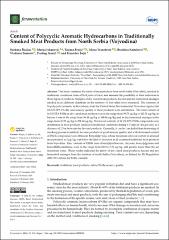| dc.contributor.author | Škaljac, Snežana | |
| dc.contributor.author | Jokanović, Marija | |
| dc.contributor.author | Peulić, Tatjana | |
| dc.contributor.author | Vranešević, Jelena | |
| dc.contributor.author | Kartalović, Brankica | |
| dc.contributor.author | Tomović, Vladimir | |
| dc.contributor.author | Ikonić, Predrag | |
| dc.contributor.author | Šojić, Branislav | |
| dc.date.accessioned | 2024-02-12T11:55:23Z | |
| dc.date.available | 2024-02-12T11:55:23Z | |
| dc.date.issued | 2024 | |
| dc.identifier.citation | Škaljac, S.; Jokanovi´c, M.; Peuli´c, T.; Vraneševi´c, J.; Kartalovi´c, B.; Tomovi´c, V.; Ikoni´c, P.; Šoji´c, B. Content of Polycyclic Aromatic Hydrocarbons in Traditionally Smoked Meat Products from North Serbia (Vojvodina). Fermentation 2024, 10, 104. https://doi.org/ 10.3390/fermentation10020104 | en_US |
| dc.identifier.issn | 2311-5637 | |
| dc.identifier.uri | https://repo.niv.ns.ac.rs/xmlui/handle/123456789/756 | |
| dc.description.abstract | This study examined the safety of meat products from north Serbia (Vojvodina), smoked in
traditional conditions, from a PAH point of view, and assessed the possibility of their reduction in
these types of products. Samples of dry cured meat products, bacons and dry fermented sausages
smoked in six different chambers on the territory of Vojvodina were examined. The contents of
16 polycyclic aromatic hydrocarbons, from the United States Environmental Protection Agency list
(16 US-EPA PAHs), and sensory quality of meat products were determined. The total content of
16 US-EPA PAHs in dry cured meat products was in the range from 99.73 μg/kg to 412.76 μg/kg; in
bacons it was in the range from 36.43 μg/kg to 188.86 μg/kg; and in dry fermented sausages in the
range from 47.23 μg/kg to 270.60 μg/kg. The lowest contents of 16 US-EPA PAHs compounds were
determined in meat products smoked in traditional conditions during 3–5 days (3–4 h per day) at a
distance of 2.5 m between the fire and products. Generally, it can be concluded that shortening of
smoking process is justified, because products of good sensory quality and with decreased content
of PAHs compounds were obtained. Benzo[a]pyrene, whose maximum allowed content in smoked
meat products is 2 μg/kg, was below the limit of detection in all examined traditional meat products
from Vojvodina. Also, contents of PAH4, sum of benz[a]anthracene, chrysene, benzo[a]pyrene and
benzo[b]fluoranthene, were in the range from ND to 2.22 μg/kg, still greatly lower than the set
maximum value. These results indicated the safety of dry cured meat products, bacons and dry
fermented sausages from the territory of north Serbia (Vojvodina), as defined by EU Regulation
2023/915 criteria for PAHs contents. | en_US |
| dc.description.sponsorship | This study was part of Project No. 451-03-47/2023-01/200134 and 451-03-47/2023-
01/200031, which is financially supported by the Ministry of Education, Science and Technological
Development, Republic of Serbia. | en_US |
| dc.language.iso | en | en_US |
| dc.source | Fermentation | en_US |
| dc.subject | traditional meat products | en_US |
| dc.subject | safety | en_US |
| dc.subject | PAHs | en_US |
| dc.subject | sensory quality | en_US |
| dc.title | Content of Polycyclic Aromatic Hydrocarbons in Traditionally Smoked Meat Products from North Serbia (Vojvodina) | en_US |
| dc.type | Article | en_US |
| dc.identifier.doi | 10.3390/fermentation10020104 | |
| dc.citation.volume | 10 | en_US |
| dc.citation.issue | 104 | en_US |
| dc.citation.rank | M21 | en_US |
| dc.type.version | published | en_US |

